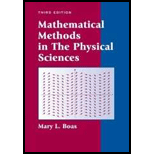
Show by the
Want to see the full answer?
Check out a sample textbook solution
Chapter 10 Solutions
Mathematical Methods in the Physical Sciences
Additional Math Textbook Solutions
A Problem Solving Approach To Mathematics For Elementary School Teachers (13th Edition)
Using and Understanding Mathematics: A Quantitative Reasoning Approach (6th Edition)
A Problem Solving Approach to Mathematics for Elementary School Teachers (12th Edition)
Finite Mathematics & Its Applications (12th Edition)
A Survey of Mathematics with Applications (10th Edition) - Standalone book
Mathematics for Elementary Teachers with Activities (5th Edition)
- Take this test to review the material in Chapters 4 and 5. After you are finished, check your work against the answers in the back of the book. Prove that the set of all singular 33 matrices is not a vector space.arrow_forwardProve the half of Theorem 3.3 (e) that was not proved in the text.arrow_forwardFind an orthonormal basis for the subspace of Euclidean 3 space below. W={(x1,x2,x3):x1+x2+x3=0}arrow_forward
 Elementary Linear Algebra (MindTap Course List)AlgebraISBN:9781305658004Author:Ron LarsonPublisher:Cengage Learning
Elementary Linear Algebra (MindTap Course List)AlgebraISBN:9781305658004Author:Ron LarsonPublisher:Cengage Learning Linear Algebra: A Modern IntroductionAlgebraISBN:9781285463247Author:David PoolePublisher:Cengage LearningAlgebra & Trigonometry with Analytic GeometryAlgebraISBN:9781133382119Author:SwokowskiPublisher:Cengage
Linear Algebra: A Modern IntroductionAlgebraISBN:9781285463247Author:David PoolePublisher:Cengage LearningAlgebra & Trigonometry with Analytic GeometryAlgebraISBN:9781133382119Author:SwokowskiPublisher:Cengage


